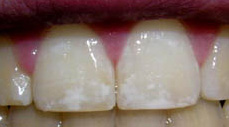Dental Problems
FLUOROSIS
Dental fluorosis is a health condition caused by a child receiving too much during during tooth development. The critical period of exposure is between 1 and 4 years old; children over age 8 are not at risk. In its mild form, which is the most common, fluorosis appears as tiny white streaks or specks that are often unnoticeable. In its severe form it is characterized by black and brown stains, as well as cracking and pitting of the teeth.
The severity of dental fluorosis depends on the amount of fluoride exposure, the age of the child, individual response, and nutritional and other factors. Although can cause fluorosis, most of this is mild and not usually of aesthetic concern. Severe cases can be caused by exposure to water that is naturally fluoridated to levels well above the recommended levels, or by exposure to other fluoride sources such as or pollution from high fluoride coal.
Dental fluorosis occurs because of the excessive intake of either through fluoride in the water supply, naturally occurring or added to it; or through other sources. Teeth are generally composed of hydroxyapatite and carbonated hydroxyapatitetitle; when fluoride is present, fluorapatite is created. Excessive fluoride can cause white spots, and in severe cases, brown stains or pitting or mottling of enamel . Fluorosis cannot occur once the tooth has erupted into the oral cavity . At this point, fluorapatite is beneficial because it is more resistant to dissolution by acids (demineralization). Although it is usually the permanent teeth which are affected, occasionally the primary teeth may be involved.
In normal doses fluoride is a healthy compound that promotes strong teeth, which has the ability to fight cavities and other problems. But sometimes, fluorosis occurs when fluoride-containing toothpastes or rinses are swallowed, instead of expelled.

This results in mottling of the tooth which shows up initially as “white spots”, progressing into permanently stained, brown mottled teeth.
The enamel in turn now beomes subject to decay, thus leading to the formation of caries, lesions or cavities. The tooth becomes more porous, with porosity of the tooth affected increasing relative to the degree of fluorosis.
The degree of fluorosis is directly related to tooth eruption.
Dental fluorosis can be cosmetically treated by a dentist. The cost and success can vary significantly depending on the treatment. Tooth bleaching , microabrasion, and conservative composite restorations or porcelain veneers are commonly used treatment modalities.
If you feel you have fluorosis, please see our dentist.






